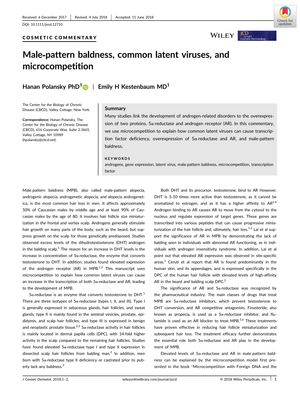Male-Pattern Baldness, Common Latent Viruses, and Microcompetition
July 2018
in “
Journal of Cosmetic Dermatology
”
male-pattern baldness microcompetition miniaturization of hair follicles frontal scalp vertex scalp androgens dihydrotestosterone DHT testosterone 5α-reductase androgen receptor AR balding scalps latent viruses Epstein-Barr virus EBV Herpes simplex virus 1 HSV-1 GABP p300 transcription complex hair loss MPB 5-alpha-reductase

TLDR Common latent viruses might contribute to male-pattern baldness by disrupting cell processes that normally suppress hair loss-related proteins.
The commentary discusses the role of common latent viruses in the development of male-pattern baldness (MPB) through a process called microcompetition. MPB is characterized by the miniaturization of hair follicles, particularly in the frontal and vertex scalp, and is influenced by androgens like dihydrotestosterone (DHT), which is synthesized from testosterone by the enzyme 5α-reductase. Elevated levels of 5α-reductase and androgen receptor (AR) expression have been observed in balding scalps. The authors propose that latent viruses, such as Epstein-Barr virus (EBV) and Herpes simplex virus 1 (HSV-1), can bind to and sequester the cellular GABP p300 transcription complex, which normally suppresses 5α-reductase and AR expression. This sequestration leads to overexpression of these proteins, increased conversion of testosterone to DHT, and ultimately, hair loss. The authors suggest that targeting the latent viruses might be a more effective treatment for MPB than the current pharmaceutical approach of inhibiting 5α-reductase and AR.



